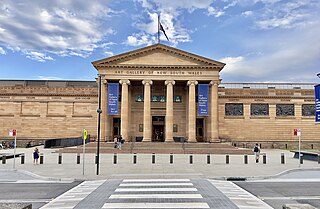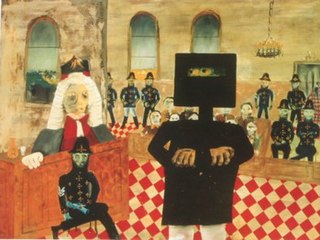
The National Gallery of Australia (NGA), formerly the Australian National Gallery, is the national art museum of Australia as well as one of the largest art museums in Australia, holding more than 166,000 works of art. Located in Canberra in the Australian Capital Territory, it was established in 1967 by the Australian Government as a national public art museum. As of 2022 it is under the directorship of Nick Mitzevich.

Australian art is a broad spectrum of art created in or about Australia, or by Australians overseas, spanning from prehistoric times to the present day. The art forms include, but are not limited to, Aboriginal, Colonial, Landscape, Atelier, and Contemporary art.

Arthur Merric Bloomfield Boyd was a leading Australian painter of the middle to late 20th century. Boyd's work ranges from impressionist renderings of Australian landscape to starkly expressionist figuration, and many canvases feature both. Several famous works set Biblical stories against the Australian landscape, such as The Expulsion (1947–48), now at the Art Gallery of New South Wales. Having a strong social conscience, Boyd's work deals with humanitarian issues and universal themes of love, loss and shame.

Sir George Russell Drysdale, also known as Tass Drysdale, was an Australian artist. He won the prestigious Wynne Prize for Sofala in 1947, and represented Australia at the Venice Biennale in 1954. He was influenced by abstract and surrealist art, and "created a new vision of the Australian scene as revolutionary and influential as that of Tom Roberts".

Albert Lee Tucker was an Australian artist and member of the Heide Circle, a group of modernist artists and writers associated with Heide, the Melbourne home of art patrons John and Sunday Reed. Along with Heide Circle members such as Sidney Nolan and Arthur Boyd, Tucker became associated with the Angry Penguins art movement, named after a publication founded by poet Max Harris and published by the Reeds.

The Art Gallery of New South Wales (AGNSW), founded as the New South Wales Academy of Art in 1872 and known as the National Art Gallery of New South Wales between 1883 and 1958, is located in The Domain, Sydney, Australia. It is the most important public gallery in Sydney and one of the largest in Australia.
John Harford Reed was an Australian art editor and patron, notable for supporting and collecting of Australian art and culture with his wife Sunday Reed.

The handwritten document known as the Jerilderie Letter was dictated by Australian bushranger Ned Kelly to fellow Kelly Gang member Joe Byrne in 1879. It is one of only two original Kelly letters known to have survived.
Robert Melville was an English art critic and journalist. Along with the artists Conroy Maddox and John Melville, he was a key member of the Birmingham Surrealists in the 1930s and 1940s. An early biographer of Picasso, he later become the art correspondent of the New Statesman and the Architectural Review.
Rhyll McMaster is a contemporary Australian poet and novelist. She has worked as a secretary, a nurse and a sheep farmer. She now lives in Sydney and has written full-time since 2000. She is a recipient of the Barbara Jefferis Award.

The Trial (1947) is a painting by the Australian painter Sidney Nolan.
John Kelly is an Australian artist.

Ned Kelly was a 19th-century Australian bushranger and outlaw whose life has inspired numerous works in the arts and popular culture, especially in his home country, where he is viewed by some as a Robin Hood-like figure.

Footballer is a 1946 painting by Australian artist Sidney Nolan. It depicts an Australian rules footballer standing before a crowd of spectators at a football match. For many years the painting was thought to be a generic image of a footballer, however Nolan later revealed that the painting is based on Bill Mohr, a star player for the St Kilda Football Club during the 1930s.

Sir Sidney Robert Nolan was one of Australia's leading artists of the 20th century. Working in a wide variety of media, his oeuvre is among the most diverse and prolific in all of modern art. He is best known for his series of paintings on legends from Australian history, most famously Ned Kelly, the bushranger and outlaw. Nolan's stylised depiction of Kelly's armour has become an icon of Australian art.
Christine Kenneally is an Australian-American journalist who writes on science, language and culture. Trained as a linguist, she has written for The New York Times, the New Yorker, Slate, New Scientist, and Australia's Monthly, among other publications. She is a great-granddaughter of JJ Kenneally, an early populariser of Australian bushranger Ned Kelly.
J. J. Kenneally was an Australian journalist and trade unionist. An early populariser of Australian bushranger Ned Kelly and his gang via his book The Inner History of the Kelly Gang and Their Pursuers (1929), he was also one of the original members of the country's Labor Party and later formed his own party.
Peter Bray Gallery was established as Stanley Coe Gallery in 1949 before being renamed in 1951, after a change of management. Situated at 435 Bourke Street, Melbourne, Victoria, Australia, it closed in 1957. Many of the major names in mid-century Australian contemporary art showed there during its brief, but very busy, lifespan.
Menzies Art Brands is an Australian art auction company which includes both the Deutscher-Menzies and Lawson-Menzies auction houses. It is part of the private company Menzies International, which also includes cleaning business Menzies Group and the vineyard Noorilim Estate. It is one of Australia's major art auction houses by takings.
The Museum of Modern Art Australia (MOMAA), alternatively named the 'Museum of Modern Art of Australia,' or, according to McCulloch, the 'Museum of Modern Art and Design' (MOMAD), was founded by Australian art patron John Reed in 1958 in Tavistock Place, a lane-way off 376 Flinders Street, Melbourne, launched previously with a survey of Modernist Victorian women artists on 1 June 1956, organised by the Reeds who had taken on the then named Gallery of Contemporary Art. It held exhibitions of important contemporary Australian and international art of the late 1950s and early 1960s. The Museum operated until 1966 and was formally dissolved in 1981.












